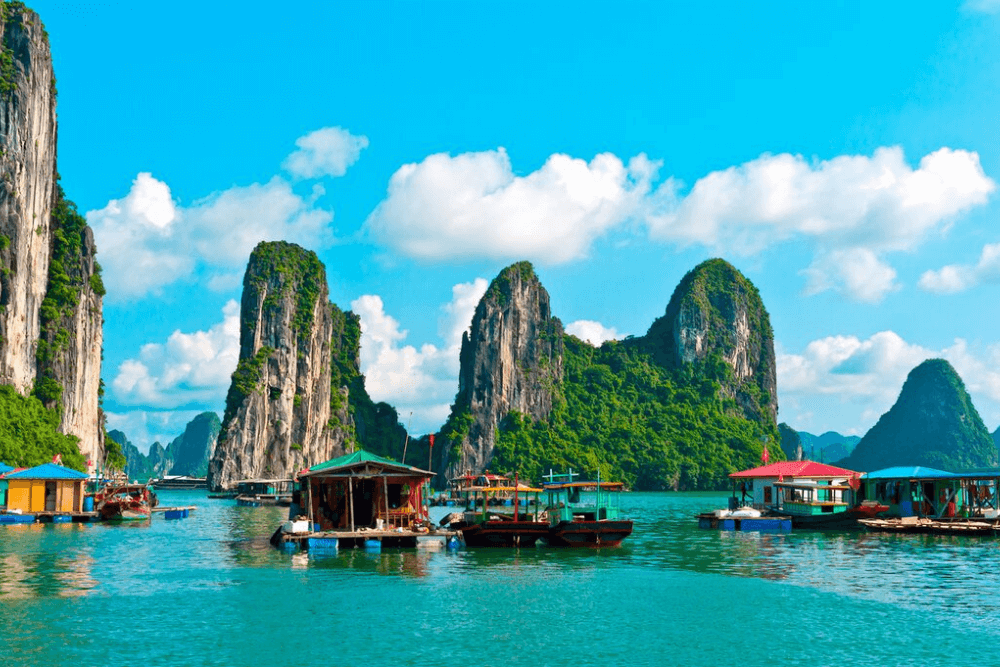Vietnam is a land of rich contrasts—where misty mountains meet sun-kissed beaches, and ancient traditions thrive alongside modern energy. Whether you’re planning your first visit or returning to discover more, one question often comes up:
Should you start your journey in North or South Vietnam?
This guide breaks down the differences in culture, climate, cuisine, and top attractions to help you decide where to begin your Vietnamese adventure.
North vs. South Vietnam: Key Differences
Vietnam’s regional identities are shaped by history, geography, and tradition:
- North Vietnam is known for its deep-rooted heritage, cooler climate, rugged landscapes, and traditional way of life.
- South Vietnam offers a tropical vibe, lively cities, bustling markets, and relaxed coastal charm.
Both regions are worth exploring, but the best starting point depends on your interests, travel season, and preferred pace.
🌄 North Vietnam Travel Guide: Culture, Mountains & History
Top Places to Visit in North Vietnam
- Hanoi – The cultural capital, filled with colonial charm, vibrant street food, ancient temples, and local life in the Old Quarter.
- Ha Long Bay – A UNESCO World Heritage site, famous for its emerald waters and limestone karsts. Perfect for cruises and kayaking.
- Sapa – Ideal for trekking through terraced rice fields and visiting hill tribe villages like the Hmong and Dao.
- Ninh Binh – Often dubbed “Ha Long Bay on land,” it offers scenic boat rides through caves and karst peaks.
- Ha Giang – A remote and rugged mountain region offering epic motorbike loops and cultural authenticity.
Best Time to Visit North Vietnam
October to April – Cool, dry weather makes this season perfect for outdoor exploration, trekking, and sightseeing.
🌴 South Vietnam Travel Guide: Beaches, Nightlife & River Life
Top Places to Visit in South Vietnam
- Ho Chi Minh City (Saigon) – A bustling metropolis that blends skyscrapers with historic war landmarks and some of Vietnam’s best street food.
- Mekong Delta – Cruise through a maze of floating markets, stilted villages, and lush green rice paddies.
- Phu Quoc – A laid-back island escape with white-sand beaches, coral reefs, and tropical resorts.
- Can Tho – Known for the colorful Cai Rang Floating Market and its peaceful riverside charm.
- Mui Ne – A beach town famous for red and white sand dunes, kite surfing, and fresh seafood.
Best Time to Visit South Vietnam
November to April – Dry, sunny weather ideal for beach trips, river tours, and city hopping.
🍜 North vs. South Vietnamese Cuisine
Vietnam’s culinary landscape shifts as you travel from north to south:
Northern Vietnamese Dishes
- Phở – The globally loved beef noodle soup, subtly spiced and deeply comforting.
- Bún Chả – Grilled pork served with noodles, herbs, and dipping sauce—Hanoi’s lunchtime favorite.
- Chả Cá – Grilled fish with turmeric and dill, served with rice noodles and peanuts.
Southern Vietnamese Dishes
- Bánh Xèo – Crispy rice pancakes filled with pork, shrimp, and bean sprouts.
- Hủ Tiếu – A lighter, sweeter noodle soup popular in the Mekong region.
- Cơm Tấm – “Broken rice” served with grilled meats, pickled vegetables, and a fried egg.
The difference? Northern dishes are generally more savory and subtle, while southern cuisine is sweet, bold, and influenced by tropical produce and international flavors.
🎎 Culture in North vs. South Vietnam
- North Vietnam tends to be more traditional, with strong influences from Confucianism, visible in local customs, formal etiquette, and historic temples.
- South Vietnam is more relaxed, entrepreneurial, and westernized, with a thriving café culture, casual atmosphere, and open-minded spirit.
If you’re seeking cultural immersion and tradition, the north is ideal. If you’re after urban energy and coastal fun, head south.
🧭 Where to Start: North or South Vietnam?
Start in the North if you:
- Are drawn to history, mountain trekking, and traditional village life
- Prefer a cooler, drier climate
- Want to explore ancient temples, ethnic cultures, and scenic landscapes
Start in the South if you:
- Crave sunshine, beaches, and tropical vibes
- Enjoy dynamic cities with nightlife and street food
- Want to experience floating markets, island hopping, and coastal towns
✨ Pro Tip: Explore Both
Many travelers choose to do a full-country route, starting in Hanoi and ending in Ho Chi Minh City, or vice versa. It allows you to witness the full spectrum of Vietnam’s beauty—from misty highlands to sun-drenched coastlines.
Final Thoughts: Vietnam Travel Comparison
Whether you begin in the north or south, Vietnam is unforgettable. The charm lies in its contrasts—ancient and modern, peaceful and bustling, flavorful and scenic. Choose a region based on your interests, or better yet, explore both for the complete experience.
Wherever you start, Vietnam will leave you with stories, flavors, and friendships you’ll carry long after your trip ends.






